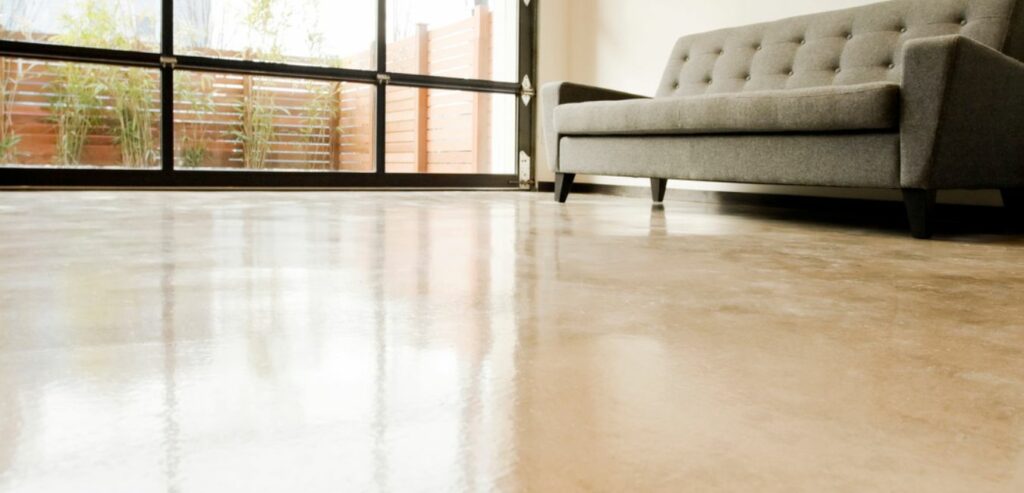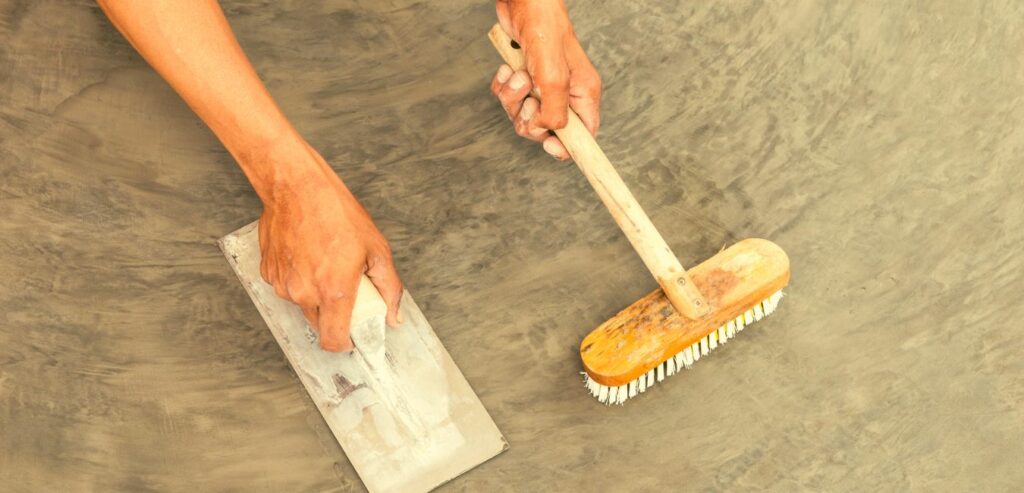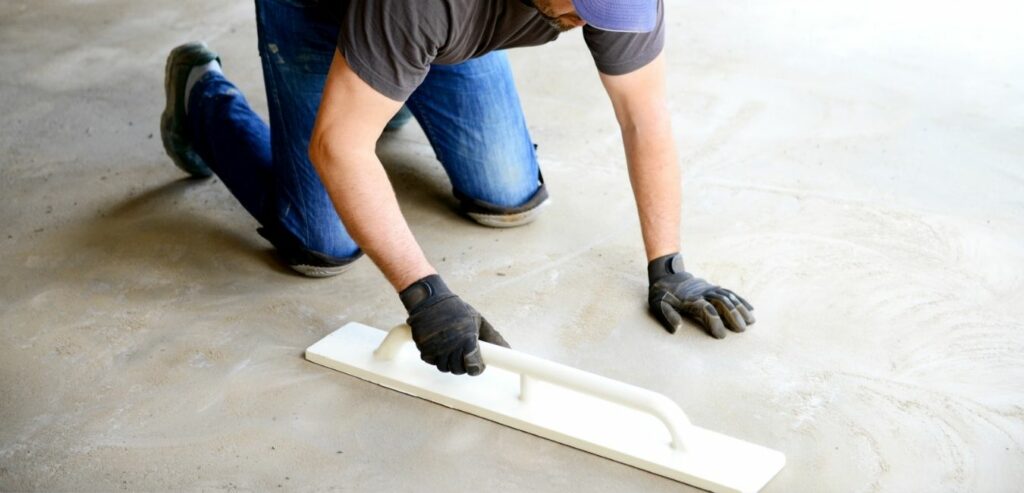Polished concrete is an attractive finishing option in residential, commercial, and industrial spaces. It keeps surfaces smooth and clean and is easier to maintain than other flooring options.
The unique appearance of polished concrete makes floors have a unique aesthetic finish, ideal for commercial and residential environments.
Polished concrete surfaces offer unmatched versatility, sophisticated appearances, and more durability than other concrete surfaces. This article will explore different design options of polished concrete and its applications in construction.
Table of Contents
What is polished concrete?
Polished concrete is when a surface is refined through a grind and seal method and honed with abrasives to cut into a concrete’s surface. Polished concrete typically has a glossy, satin-like finish. Each cut refines the appearance of the concrete.
Grinding tools with abrasives are used to refine a concrete surface. The continual removal of protrusions and surface scratches on concrete makes a surface that resists damage and reflects light naturally.
The concrete polishing process is combined with a penetrant chemical known as densifier or hardener. The densifier penetrates the concrete creating a hard surface. It also makes the surface water-resistant, reduces the porosity of concrete, and helps fill the aeration holes in concrete.
Densification improves the appearance of concrete and increases the stain resistance of a concrete floor, as a polished floor works well with sealants.
There is also mechanically polished concrete prepared using heavy machines and is more long-lasting and durable under heavy traffic.
Pros and cons of polished concrete
Like all other flooring systems, polished concrete has some advantages that make it an excellent choice for finishing. Generally speaking, polished concrete surfaces have very few disadvantages. Below is a list of the pros and cons of this type of concrete.
Pros of polished concrete
- Affordable: Polished concrete surfaces are more affordable than other smooth floor finishes like marble, hardwood, and tile. Most polished surface installations are cheap, especially with an already existing concrete slab. The price savings are not only at installation but also over the concrete’s lifespan.
- Easy to maintain: These surfaces are easy to maintain, unlike other floor surfaces that require stripping, waxing, and refinishing. A polished concrete surface needs no maintenance after installation. Durable: Polished concrete surfaces are more durable compared to other finishes. There is a minimal likelihood of failure by breaking compared to other flooring systems, and there will be no need for repair and touch work.
- Immune to mold: Other flooring systems are easily damaged by moisture and mold, but polished concrete is immune, making it an excellent choice, especially for asthmatics.
- Versatile: Concrete finishes give owners more coloring and design options and can be used in indoor and outdoor applications. You can also incorporate stenciled graphics and decorative engravings to the surfaces.
- Environmentally friendly: There are no harmful additives and chemicals involved in installing polished concrete surfaces, unlike hardwood floors and vinyl carpets. They are also resistant to allergens, fungus, and mustiness.
- Thermal shock resistance: One can apply thermal shock-resistant coatings to concrete floorings to ensure deterioration of the concrete surface does not occur under the subjection of hot water or steam washes.
- Slip-resistant: You can minimize injuries and falls from polished floors, especially in commercial settings, using non-slip epoxy to your coating surface.

Cons of polished concrete:
- Hard: Its strength and durability can also be a drawback, as the hard surface can be challenging to stand on for a long time. You can use anti-fatigue mats in areas where employees might be standing for long hours.
- Cold: Concrete floors do not retain heat very well, and they can get chilly, especially in the winter months. To minimize heat loss, you might need to embed heating cables in the concrete floor.
- Loud: Sometimes, concrete floors can be noisy, like ceramic tiles, hardwood, or bamboo floors. You can furnish some spaces with rugs, acoustic wall panels, and drapes to block or absorb sound.
How much does polished concrete flooring cost?
A polished concrete floor finish costs $3 to $12 per square foot. The price varies with the type of finish you want for your project.
A basic polished concrete finish costs $3 to $5 per square foot. The surface is polished to a moderate shine, there is only one layer and color of stain, and such a finish requires minimal preparation.
A mid-range finish costs $5 to $8 per square foot. It allows for some customization, has a glossier finish, takes more extensive surface preparation, and has better design patterns than a basic finish.
A high-end finish of polished concrete costs $8 to $12 per square foot. It offers multiple color matches and elaborate design patterns and takes more extensive grinding and surface preparation.
There are a few factors that affect the overall cost of polishing concrete. These are:
- Gloss or shine level: The gloss level determines the steps necessary for the polishing process. The glossier the surface, the more the polishing and the costlier the project.
- Area: A higher square footage drives up the overall costs.
- The number of rooms: When installing polished concrete flooring, the number of rooms increases the workaround necessary between doorways and edges, increasing the project’s labor costs.
- Current flooring: If the existing flooring system needs to be removed, it drives up project costs, affecting the surface preparation costs. If a surface is carpeted or covered with linoleum tiles, it will increase the labor costs for surface preparation.
- Existing surface: If some cracks or gouges need repairs before polishing, it will cost more to repair the surface. If there is also a need to install an overlay on the surface, it will cost more. The extensive surface preparation can add up to $2 per square foot.
- Type of design: The design has one of the most significant impacts on concrete elements, from polishing simple grain concrete to elaborate custom designs.
- Commercial vs. residential: Polished concrete tends to be cheaper in commercial projects than in residential projects.
How to install polished concrete flooring
Installing a polished concrete floor is not an easy task and takes a lot of planning. Most polished concrete floors follow the phases below.
- Surface preparation: This entails preparing the concrete surface to ensure proper use. Concrete will be cleaned, making it ready for resurfacing or polishing.
- Polishing: If you already have a concrete floor, the next step is to use a grinder to remove the impressions and protrusions on the concrete surface.
- Sealing: After polishing, the floor is cleaned using a non-abrasive cloth that removes debris from the surface. The next step is applying a sealer, a protective finish that adds to the durability of concrete.
These are the main steps in installing a polished concrete floor. Ensure you have a good team with experience and precision for a world-class finish.

How long does it take to install polished concrete flooring
The time it takes varies from job to job. Small jobs like basement floors can take 5 to 6 days, and complex, more decorative jobs like overlays and custom designs take more time.
The surface condition also affects the time needed to polish the surface. An easy to prepare surface takes less time to polish. A floor that requires extensive preparation will add a day or two to your schedule.
The size of the project, complexity, ease of access, and dry times needed after application of each coat also increase the time required to install polished concrete surfaces.
In a new concrete slab, it is nest to wait for it to cure completely before starting polishing the surface.
How to maintain polished concrete flooring
Though polished concrete floors are durable, they need minimal maintenance to reduce dirt and grime accumulation that can abrade the surface. The frequency of maintenance largely depends on the traffic the floor experiences, with high traffic areas requiring more frequent cleaning.
The first step is dust mopping the floor with a microfiber pad to keep off dirt particles from the floor. Dust particles are abrasives that can ruin a polished concrete surface.
The next step is wet mopping the floor using clean water and a mop for small areas. For areas with extensive square footage, use a non-abrasive pad. Ensure you clean spills as soon as possible to prevent them from being absorbed on the surface.
As you clean, ensure the cleaning solution does not dry on the concrete surface. You can achieve this by cleaning small portions before proceeding.
Summary
You now understand the advantages, drawbacks, and cost of installing polished concrete. Polished floors are versatile and customizable thanks to their variety of designs, making them a popular flooring option. In terms of sustainability, you can also use polished concrete floors with existing floor slabs without additional materials.
If you are planning to install a polished concrete floor, it is best to solicit the services of a professional, as this way, you will ensure your project is correctly done. You will also save time and money as attempting to undertake such a project on your own may result in disaster.

